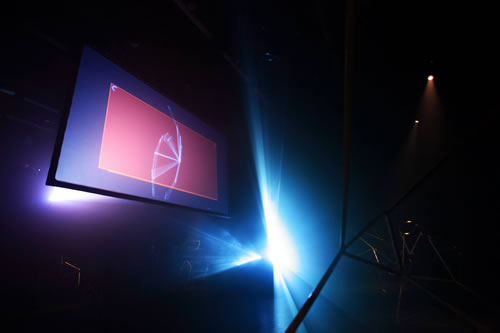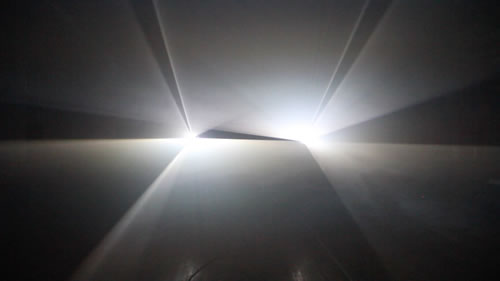[GALLERY]
new eyes — for [single] player (2017)
for 2 projectors, HUD, haze/smoke, Xbox/PS4 controller and 1 performer
new eyes — for [single] player is an audiovisual performance that seeks to invert the relationship between player and instrument. The instrument does not in fact require the player, for it is fully automated. Each move or intervention by the player is an expression of their agency within the system. During the development of the piece, I have come to think about the player’s role as managing the output of light and sound (through time) on a human scale. Each player has different “playing styles” and this offers insight into their own interests and tolerances. Each performance will therefore be different — everything is generated in real time. The goal of the work is to allow player, computer and “composer” agency to act on one another while retaining a clear identity for the work.
http://remysiu.com/new-eyes-for-single-player
What were your motivations for moving toward working with light?
My background is in acoustic and electroacoustic composition, but I have worked extensively in contemporary dance and experimental theatre. In the Vancouver artistic milieu, my peers predominately work with devised processes: there are no scripts and, in the case of dance, movement material is not predetermined and “loaded” onto the dancers. These environments often ask everyone in the room to work in a less hierarchical way, often riffing together to create material, and then to form a vocabulary. My original role in these processes was to work with sound, with a setup that allowed me to react quickly to what was happening in the room — either to work against it or to support it. In a way, it was my role to help create a larger frame outside of the action happening on stage. As the years passed, it became clear that we continued to make compromises with light; the light would always come last. This made no sense in the way we wanted to work, so I moved to work with LED and projector light. There were so many possibilities if I could respond to the performers with both light and sound, and vice versa; I could improvise scenography. I have since integrated light into my solo practice as a way for me to achieve my compositional aspirations.

Outside of the artistic reasons, there are very economical reasons to pursue light. In Vancouver, it was very difficult to have regular access to a familiar rehearsal space. We were jumping from one space to another and there was no way to guarantee a proper lighting setup. This closed many possibilities for us. Now, I can bring my entire light and sound equipment with me to every space, and can tech the show in very little time, while still affording high degrees of specificity.
In what way(s) do you approach and articulate the relationship between sound and light in your work?
My solo practice has been focused on what I would consider “algorithmic theatre”. I build performance apparatus for not only highly specialized performers, but also, on the opposite end, anybody. A strong focus of these works is to allow the performance to be different every time and to change based on the performer(s). To do this, I see myself no longer composing moment to moment (or note to note), but rather exploring “game mechanics” that dictate how the performer interacts with the system and how the system interacts with them. These core mechanics generate their own moments from an interplay of player agency, computer agency and my own compositional agency.
In my work, sound and light serve to manifest these game mechanics for the audience and the performer(s). When I begin working on something new, I think of these mechanics first, then I take an almost utilitarian approach to the sound and light, and then work from there. It almost always begins with a 1:1 relationship, so as the system evolves and begins to “speak”, it gives me reasons to change this relationship, and then a way to organize those relationships.

An example from new eyes — for [single] player: I wanted the system to drift back and forth between instability and stability based on the performer’s actions. If the player did not make any actions, the system would drift into instability as the control is relinquished to the computer. If the player made actions, they could steer the work toward states they desired.
I began by thinking of such states in both the sound and light individually, and then the degree to which they would be coupled. The work drifts back and forth on this spectrum in a fluid way, influenced by the performer. The sound and light communicate whether it is in a stable or unstable state or somewhere between and more ambiguous, giving an insight into the performer’s individual “playing style”. The sound and light, and their coupling, have many degrees of affect, but when used to surface the mechanics, they also become functional on a conceptual level.
How do you feel that you, with your multidisciplinary experiences, enrich the language of light and sound-based practices compared with, for example, a lighting artist who has dedicated an entire career to a single discipline?
I feel that if an artist is too entrenched in one discipline, it gives them a very narrow field to draw from when addressing their artistic challenges. If we have challenges in our disciplines, it seems useful and often necessary to look outside to see how others have tackled these concerns. I think this makes the work more holistic and exciting, and I am personally drawn to practices that reach outward in all different directions.
My interest in game mechanics in a performing arts context comes from a place of working in dance and theatre. In those processes, we often talk about the “presence” of the performer, the “stakes” of the performance and the performer’s “honesty” in their intent. How do we make every action that the performer makes necessary and not simply for theatrics — for show? How can the performer be making meaningful choices in performance?
For this reason, I am trying to create friction between the system and the performer. I also see these real-time digital systems defined by game mechanics as another way to think about “scores”, a mediation tool that comes from my music background.
(I want to make a quick shout out to my collaborator Paul Paroczai, as we often programme these systems together.)
Social top